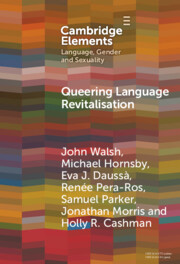5 results

Queering Language Revitalisation
- Navigating Identity and Inclusion among Queer Speakers of Minority Languages
-
- Published online:
- 08 January 2025
- Print publication:
- 30 January 2025
-
- Element
- Export citation
15 - Channel Islands French
- from Part III - Multilingualism in Britain and Ireland: Minority Languages
-
-
- Book:
- Language in Britain and Ireland
- Published online:
- 17 October 2024
- Print publication:
- 31 October 2024, pp 373-385
-
- Chapter
- Export citation
11 - Scottish Gaelic
- from Part II - Multilingualism in Britain and Ireland: The Celtic Languages
-
-
- Book:
- Language in Britain and Ireland
- Published online:
- 17 October 2024
- Print publication:
- 31 October 2024, pp 288-313
-
- Chapter
- Export citation
Chapter 9 - Hecate
- from Part III - Public Reimaginings
-
-
- Book:
- Reimagining Shakespeare Education
- Published online:
- 02 February 2023
- Print publication:
- 23 February 2023, pp 145-158
-
- Chapter
- Export citation
10B - Task-Based Language Teaching and Indigenous Language Revitalisation
- from Part IV - Methodology and Pedagogy
-
-
- Book:
- The Cambridge Handbook of Task-Based Language Teaching
- Published online:
- 19 November 2021
- Print publication:
- 09 December 2021, pp 359-373
-
- Chapter
- Export citation

